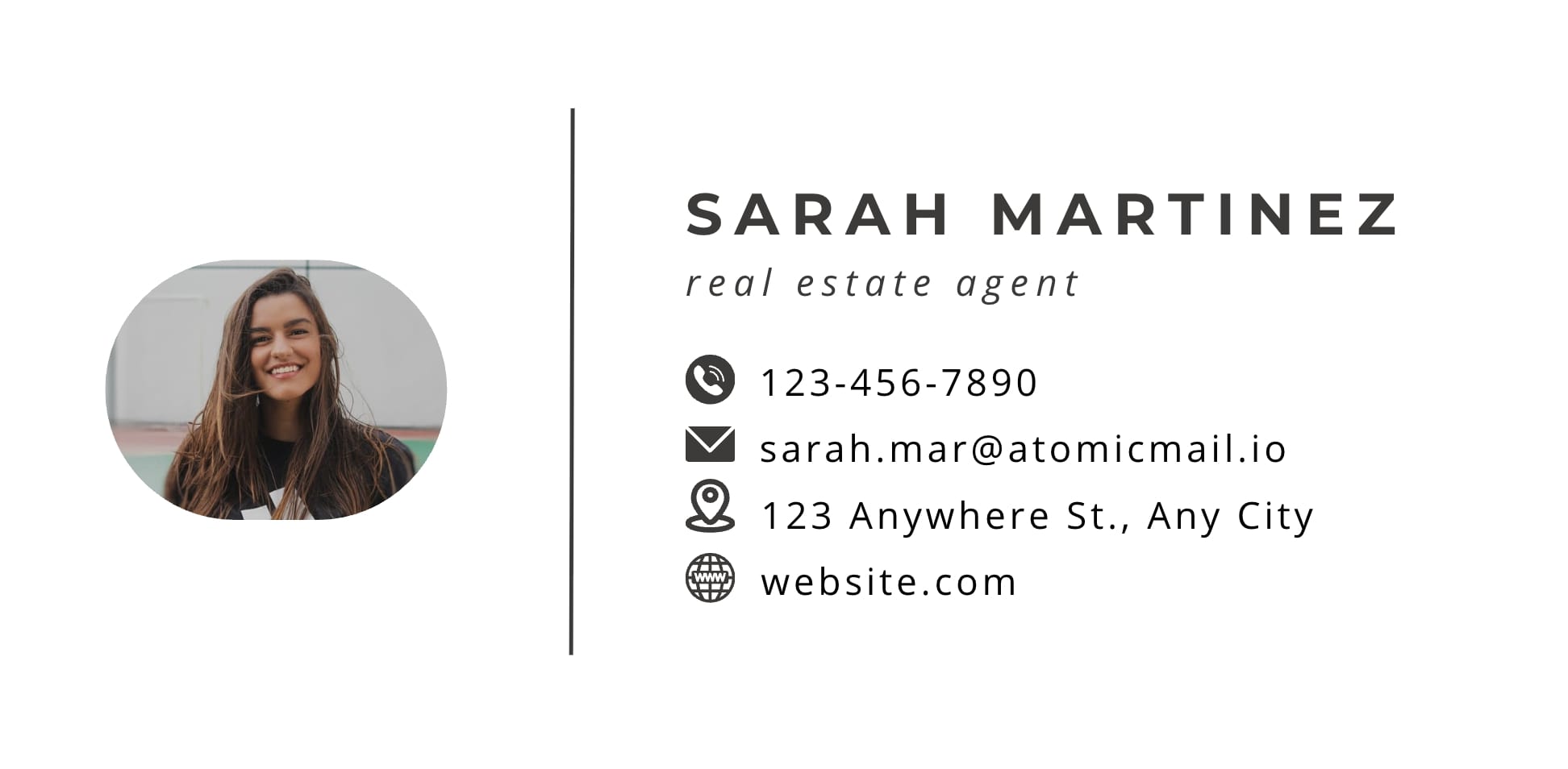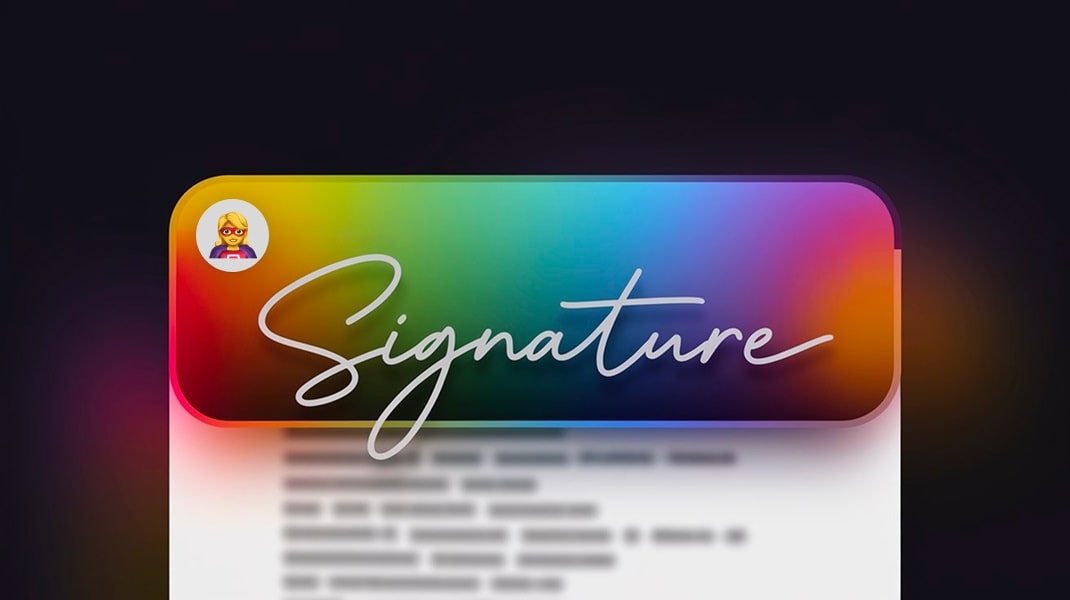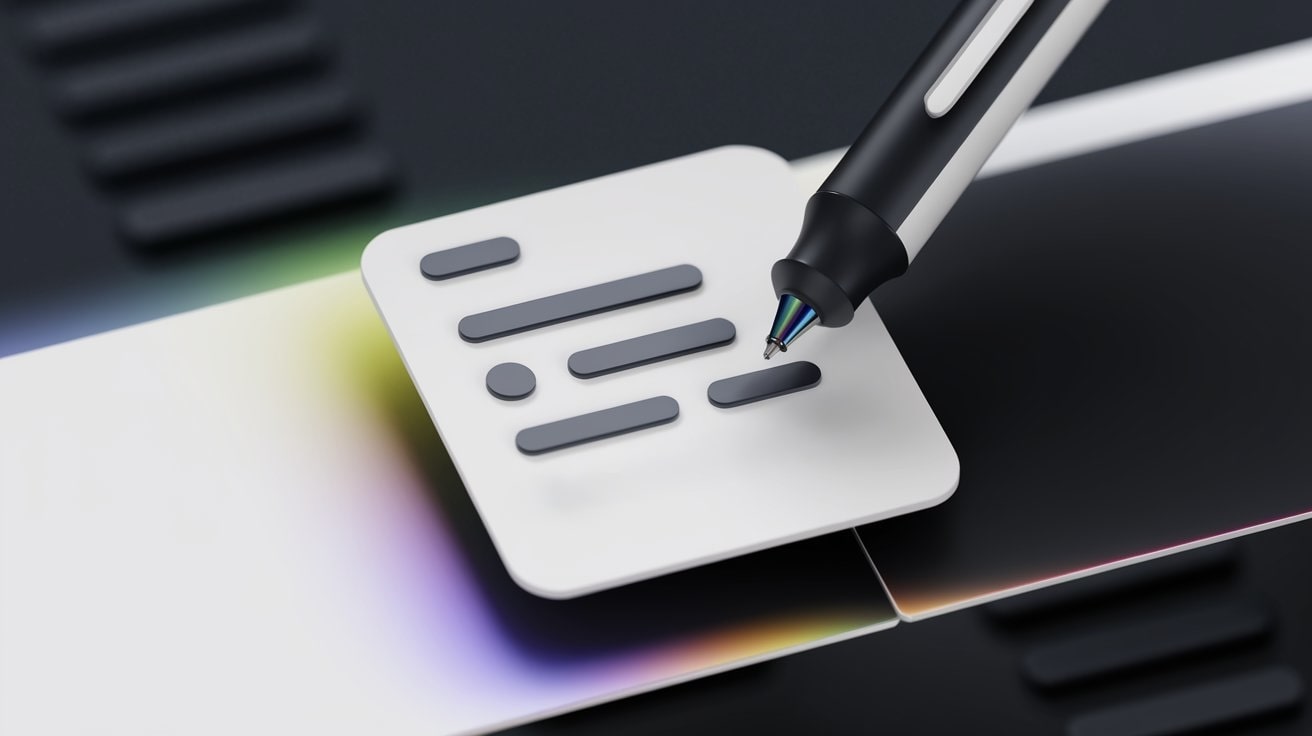What Is an Email Signature
An email signature, also called a signature block, is the small section at the bottom of an email that includes your name, contact information, title, and often more.
It might look simple, but it's actually one of the most underused tools when it comes to professional and personal communication.
What is a Signature Block and Why It Matters
An email signature is like a digital business card, giving the person receiving it the sender's essential contact information, like their name, job title and phone number. This basic purpose sets up a legitimate and easy-to-use system for getting in touch.
But these days, email signatures have become so much more than just a static function. It's now used to strengthen a brand's identity, run targeted marketing campaigns, share legal disclaimers and show personal or corporate values. The way it's changed from a basic text block to a rich, interactive footer is really important to understand. Every email sent is an opportunity to communicate more than just the message in the body; it's a chance to build brand equity, drive engagement, and generate leads.
Benefits of an Email Signature
Still not convinced? Let's cut to the chase. The benefits are very measurable.
- Trust & authenticity – People are more likely to take your email seriously when it ends with a well-designed, professional signature.
- Brand recognition – Using company colors, logos, or taglines makes your communication consistent and memorable.
- Marketing leverage and lead generation – The average office worker sends about 121 emails a day, which represents millions of brand impressions for a mid-sized company every year. You can use this existing traffic for marketing at virtually no extra cost. Include a promo, clickable call-to-action (CTA), link to your landing page or latest article, or booking calendar. Turn every email into an engagement opportunity without increasing ad spend.
- Efficient networking – Email signature provides all your contact points (like LinkedIn, phone, website, and more) without the recipient having to hunt for them.
- Internal Communications and Culture
- Signatures also serve as an internal communications channel. HR and internal marketing can use banners to announce company news, promote job openings, or share corporate updates.
- Compliance & legal — For some industries, like legal and healthcare, signatures are a compliance requirement (e.g., confidentiality disclaimers, HIPAA notices).
So, an email signature is a great way to make a low-cost, high-impact branding and marketing move. It affects how people see how professional you are, builds trust, and helps you achieve your business goals. But a lot of organisations don't pay enough attention to this, resulting in inconsistent, off-brand signatures that can lead to missed opportunities or even harm the company's reputation.
The Structure of a Great Email Signature
The best email signatures follow a clear structure that guides the eye and gets people to take action. It's a great example of micro-marketing and email signature design.

What to Include (And What to Leave Out)
Must-haves:
- Your full name (often bolded or slightly larger for prominence)
- Your title or role (if relevant)
- Company name and logo (for professional emails)
- Primary contact methods (email, phone, website)
- Optional: social media links (LinkedIn is the safest bet)
The blacklist:
- Multiple fonts or sizes – makes it look messy
- Multiple phone numbers – don't create a paradox of choice; give the best one to reach you
- Long quotes or irrelevant slogans – waste of space
- Too many links – it’s not a brochure
- Giant images or gifs – they don’t load well and break often
Visual Hierarchy and Brand Elements
Your signature should be quick and easy to scan – under three seconds is ideal. Visual hierarchy is how you achieve that. It's about organising elements to show their order of importance.
Your name is the headline, so it should be the most prominent. Your title and company are the sub-headline. Your contact details are the body copy. Use visual dividers (like a simple | or a thin graphic line) to create separation and order.
Your email signature design must include your brand elements.
- Colors: Use your brand's hex codes, but sparingly. One or two accent colors are enough.
- Fonts: Stick to web-safe fonts (Arial, Verdana, Georgia) to ensure consistent rendering across all email clients.
- Company logo: A high-quality logo is key to linking the email to the company's image and is a big part of brand recognition.
- Professional headshot: A headshot is a great way to add a human element, building rapport and trust, especially in client-facing roles. The photo should look professional and be high-res.
⚠️ Always optimize for clarity over creativity.
Think of it like a landing page in miniature: one shot to communicate who you are and why it matters.
Marketing and Engagement Levers
Your signature can do more than just close a message. These components turn the signature into a tool for driving specific actions.
- Call-to-Action (CTA): A CTA is a direct instruction, like "Book a Demo," that encourages the person receiving it to take a specific next step. A strong CTA is clear and benefit-oriented.
- Promotional banners: These eye-catching graphics are great for promoting information that's time-sensitive, like events, sales, or new content.
- Social media icons: Clean icons are a great way to link to professional social media profiles that won't take up too much space, but it's probably best to stick to 3 or 4 relevant platforms.
- Calendar booking link: A direct link to a scheduling tool like Calendly is a major efficiency tool, doing away with the hassle of arranging meetings.
Some of the best email signature examples include subtle CTAs (calls to action) that don’t interrupt the flow. Just a clean hyperlink or an understated button.
Mobile-Readiness
Over 60% of emails are opened on mobile. If your signature doesn’t look good on a phone, it’s broken.
- Keep it single-column
- Avoid horizontal layouts with multiple logos or buttons
- Use alt text for images (they often don’t load)
- Test how it appears on small screens before you send it for the first time
Many email signatures look great on desktops but can be a mess on smartphones. Always check both.
Professional Email Signature Examples
Your email signature is a reflection of your professional context. Below are some professional email signature examples.
Corporate and B2B Email Signature
Considerations:
- Consistency across departments and roles
- Legal disclaimers or compliance footnotes (GDPR, HIPAA)
- Formal tone, professional fonts
- Branded colors and logo placement
Example:
Entrepreneurs and Freelancers Email Signature
Considerations:
- Flexibility to show personal branding
- Showcases your product or service in a low-key way
- Encourages conversation and trust
Example:
Tech/Startup Professionals Email Signature
Considerations:
- Slightly informal but competent and clean
- Use of tools like GitHub, Medium, or Calendly
- Keeps things lean and digital-first
Example:
Marketing Professional Email Signatures
Considerations:
- Eye-catching, call-to-action focused
- Strong personal branding
- Lead-gen link or latest campaign
- Use UTM parameters (?utm_source=email_signature&utm_campaign=q3_report) to measure exactly how much traffic and how many leads your signature generates
Example:
Personal Email Signature Examples
Your personal emails deserve just as much consideration. Whether you're emailing a teacher, a landlord, or simply keeping in touch with friends, you still probably want to make a good impression.
Minimalist Email Signatures for Everyday Use
Considerations: The focus here is on elegance and respect for the recipient's inbox. No logos, colours or marketing. Just the bare essentials needed to identify you and provide a key method of contact. It’s a confident and clean design that is incredibly versatile for day-to-day communication.
Example:
Creative and Artistic Formats
Considerations: This is for designers, artists, illustrators, and writers. Your signature is a micro-portfolio. It can showcase your aesthetic. But be warned: this is a high-risk, high-reward strategy. Your creative email signature design MUST be flawlessly executed with clean html email signature code and be 100% mobile-responsive. If it breaks, it makes you look worse than having no signature at all.
Tips:
- Show your work visually (but keep file sizes small)
- Link to portfolios or latest pieces
Example:
Academic and Student Email Signature
Considerations: In academia, credibility is the most important thing. Your signature should clearly show who you are and what you've done. Including your student/researcher ID is a big plus – it's a persistent digital identifier that sets you apart.
Example:
Email Signature Lifehacks
Here’s how to take your signature from forgettable to functional.
Design Principles
The table below gives you a quick summary of the most important things to do and not do when it comes to email signature design and technical setup.
💡 Western readers scan in a Z or F pattern. Place your most important element (your logo) in the top-left and your key call-to-action on the bottom-right. This follows the natural eye-flow.
HTML vs Plain Text: When and Why
HTML signatures allow styling – bold fonts, images, logos, links. Great for brand recognition and visual clarity. Images can be embedded (increasing email file size) or hosted on an external server (keeping file size small).
Plain text signatures are universal. They won’t break in older email clients or text-based devices. Ideal for tech support teams, developers, or when replying in secure or minimalist environments.
When to use HTML:
- Outbound marketing
- Sales or onboarding
- Brand awareness
When to use plain text:
- Internal comms
- Developer-to-developer emails
- Emergency backups
Embedding Logos vs Linking Them
Embedded images = show up directly in the email. But they increase message size and can trigger spam filters.
Linked images = load from an external server. Smaller email footprint, but risk of broken images if links die or are blocked. The huge downside? Most modern email clients, from Outlook to Apple Mail, now block images from loading by default to protect user privacy. Your recipient just sees an empty box until they click "Download Images."
What to choose? For a marketing business email signature, linking is necessary for tracking. For a 1-to-1 professional email signature, a highly optimized (under 10kb) embedded logo is often more reliable for ensuring your brand is always seen.
Using QR Codes for Contact Sharing
A QR code is the cool, techy lifehack that seems to do everything. The idea is pretty tempting: bring your digital emails into the real world.
A simple scan could:
- Instantly add your contact details to their phone.
- Open your design portfolio in their browser.
- Direct them to a private landing page with a special offer.
- Allow them to download your company's latest whitepaper.
However, many users today are wary of QR codes, thanks to a surge in quishing attacks (QR phishing). Malicious QR codes in emails can redirect to fake login pages or malware traps.
Safe use:
- Only use QR codes in email signatures if they link to verifiable pages (e.g., your public LinkedIn)
- Add a label: “Scan to save contact info – safe link”
- Avoid QR codes in first-time cold emails
- Consider trusted tools like Uniqode's QR Code Generator to link to LinkedIn profiles for a seamless process.
Signature Generators vs Custom Code
Generators are fast and easy. Such tools let you drag-and-drop your way to a sleek layout, but they can be limited.
Custom code gives you full control – responsive layout, smart conditionals, even dynamic content pulled from APIs. But it takes dev skills and ongoing maintenance.
Best of both worlds: Use a generator as a starting point, then tweak the code to fit your needs.
Tools to Help
- Email Signature Generators: Wisestamp, HubSpot
- AI Tools: ChatGPT, Gemini, Perplexity, DeepSeek; AI can now help write clean HTML for your signature. You can describe a layout, and they can generate the code. It can also help draft different versions of your bio or CTA text.
- Design tools: Canva for visuals (they even have a dedicated email signatures page with ready-to-use templates), Figma for layout prototyping
- Email testing platforms: Litmus, Email on Acid – test how your signature looks across 90+ email clients
Email Signature Etiquette in 2025
Having a powerful tool is one thing. Knowing when and how to use it is another thing. Here are some unwritten rules of modern signature etiquette.
Should You Use a Different Signature for Replies?
Yes.
A full signature with logo, CTA, and social links looks great in the first email. But repeat that five times in an email thread, and it starts to feel like spam.
Best practice:
- Use a full signature in the initial email
- Use a condensed signature for replies (name + contact line is enough)
International Communication Tips (Multilingual Signatures)
If your contacts span multiple regions, consider a bilingual or multilingual email signature.
Example:
Cultural sensitivity matters. In some regions, using first names only is too casual. In others, it’s expected. If you’re unsure, mirror the recipient’s style.
Also: Be careful with emojis. What’s friendly in one country may be unprofessional in another.
When NOT to Use a Signature at All
Yes, sometimes your emails don’t need a signature at all. For example:
- Internal chat-style convos (like Slack-over-email threads)
- Quick confirmations (“Got it, thanks!”)
- Transactional responses (“Payment received.”)
Clutter is the enemy of speed. If your reply is one line, your signature probably doesn’t need to be six.
Why Choose Secure Email Services (Like Atomic Mail)
Now you know how to create the perfect email signature – clean, branded, engaging. But are your messages secure when you hit send?
These days, trusting the big tech companies with your inbox is a risky business. They scan your emails, store them, and sometimes even share them. And what about your email signature with private info? It's just another piece of data to exploit.
That’s why secure email is foundational in 2025.
A secure email provider helps you:
- Keep your messages encrypted
- Prevent unauthorized access – even from the provider itself
- Protect sensitive contact information in your emails and signature blocks
- Reduce phishing and spoofing attempts
- Stay anonymous and in control of your data
How Atomic Mail Ensures Your Full Email Is Private and Secure
Here’s how we protect you and your communication:
- Advanced end-to-end encryption: Your emails are sealed before they leave your device and can only be opened by the recipient. Simple encryption for both internal and external communication.
- Zero-access encryption: We can’t read your emails, ever. Not technically possible.
- Anonymous sign-up: No real name, no phone number, no additional email required to create an account.
- Free email aliases: Create multiple addresses to shield your real one. Use aliases for newsletters, clients, separate identities, or just for better email organisation.
- Seed-phrase recovery: Like a crypto wallet. If you lose your password, recover access using a private phrase – no SMS, reset links, or human involvement.
- GDPR-compliant to the core: We follow strict data privacy standards. No loopholes, no grey areas.
- No ads, no tracking: We don’t show ads or monetize your data.
- Metadata protection: We minimize what’s stored and what’s visible.
Whether you're sending a pitch, a CV, or a simple "thank you," Atomic Mail makes sure it stays private.
Ready to Lock Down Your Inbox?
Your signature says who you are. Let your email provider say what you stand for.
🔒 Join Atomic Mail today



